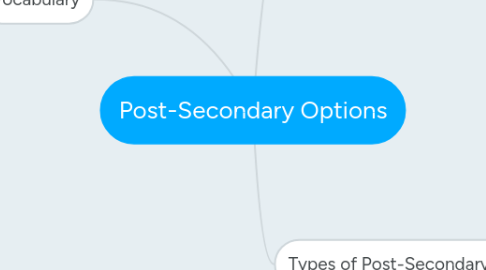
1. Vocabulary
1.1. Tuition
1.1.1. The amount of money paid for each credit hour of enrollment--does not include the cost of books, fees, and room and board
1.2. Distance Education
1.2.1. Mode of delivering education to a person's location
1.3. ACT and SAT
1.3.1. American College Test and Scholastic Aptitude Test
1.3.1.1. Both are designed to test a student's knowledge in basic areas such as English, math, science, and social studies
1.4. FAFSA
1.4.1. Free Application for Federal Student Aid
1.4.1.1. Basic form that must be filled out for students who wish to apply for Federal Student aid programs
2. Types of Post-Secondary Schools
2.1. Vocational Schools
2.1.1. Privately owned and operated schools that offer a wide variety of training options
2.1.2. Computer technology, cosmetology, mechanical repair, paralegal services, medical services, etc.
2.1.3. Take 5-12 months to as much as 3 years to complete
2.1.4. Study programs at these schools prepare students for specific careers
2.1.5. Technical Schools
2.1.5.1. Teaches mechanical and industrial arts and how to do it
2.1.6. Privately owned and operated schools
2.2. Public Colleges
2.2.1. Funded by the state
2.2.2. Less expensive than private colleges
2.3. Private Colleges
2.3.1. Funded by endowments
2.3.2. Cost is usually higher than public colleges
2.4. Community Colleges
2.4.1. Can transfer into a 4-year college or public universities
2.4.2. Junior Colleges
2.4.2.1. Usually a private school
2.4.3. Offer 2-year Associate's degrees
2.5. Universities
2.5.1. 4-Year
2.5.1.1. Offers programs with opportunities to earn a master's degree, doctorate, or professional degree
2.5.2. Offer bachelor's degrees in many fields of study
2.5.3. 2-Year
2.5.4. Public
2.5.4.1. Funded by the state
2.5.4.2. Less expensive than private colleges
2.5.5. Private
2.5.5.1. Funded by endowments
2.5.5.2. Cost is usually higher than public colleges
3. Degrees
3.1. Professional
3.2. Graduate's Degree
3.2.1. Master's
3.2.1.1. After you get your bachelor's degree--beyond 4 years
3.2.2. Doctorate
3.2.2.1. After you get your master's degree
3.3. Undergraduate's Degree
3.3.1. Associate's
3.3.1.1. 2 Years
3.3.2. Bachelor's
3.3.2.1. 4 Years
